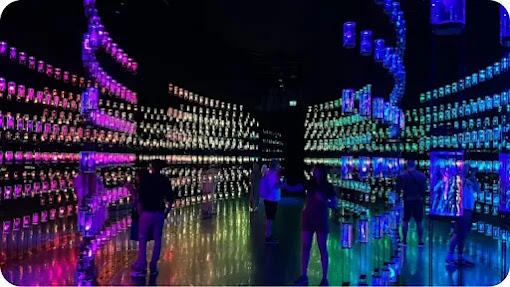A Future of Choice: Navigating the Diverse Offerings of the Museum of the Future
Introduction
Museums
have always been a gateway to the past, allowing us to explore the rich
tapestry of human history, art, and culture. However, as we step into the
future, museums are evolving to offer an even more diverse and immersive
experience. The "Museum
of the Future" promises to be a place where choice reigns supreme,
enabling visitors to tailor their museum experience to their interests and
preferences. In this blog post, we will delve into the exciting possibilities
that the Museum of the Future holds for us and how it will revolutionize our
approach to learning, art appreciation, and historical exploration.
A
Seamless Fusion of Digital and Physical
One of
the defining features of the
Museum of the Future is its seamless integration of digital and physical
elements. Traditional artifacts and exhibits will be augmented by cutting-edge
technology, offering visitors an immersive and interactive experience.
Augmented reality (AR) and virtual reality (VR) will transport visitors to
different time periods, allowing them to walk alongside dinosaurs, witness
historical events, or explore distant galaxies. This fusion of the real and the
virtual will make history and culture come alive like never before.
Personalized
Experiences
Imagine
entering the Museum of the Future, and instead of following a predetermined
path, you are given the power to customize your visit. Advanced AI algorithms
will analyse your interests and preferences, suggesting personalized routes
through the museum. Whether you are a history buff, an art connoisseur, a
science enthusiast, or a child with a thirst for knowledge, the museum will
cater to your specific interests. You can choose to deep-dive into ancient
civilizations, focus on contemporary art, or embark on a scientific journey
through the cosmos.
Interactivity
and Hands-On Learning
The
Museum of the Future will be a place where learning is not confined to
reading plaques or listening to audio guides. It will be a place of active
engagement. Visitors will be encouraged to touch, interact, and experiment with
exhibits. Want to understand the principles of physics? You can build your own
simple machines and witness the laws of physics in action. Interested in art?
Create your own digital masterpiece or collaborate with an AI artist to produce
something truly unique.
The
Power of Multisensory Storytelling
Storytelling
has always been a powerful tool in museums, but the Museum of the Future will
take it to the next level. Using a combination of visual, auditory, and tactile
elements, museums will create immersive narratives that evoke emotions and
connect visitors to the stories being told. You might find yourself in the
heart of a World War II battlefield, surrounded by the sounds of conflict, or
immersed in the vibrant colors of an ancient market.
Global
and Remote Access
The
Museum of the Future will not be limited by physical boundaries. Thanks to
advanced telepresence technology, people from around the world can visit the
museum virtually. This opens up a world of possibilities for those who may
never have the opportunity to travel to a physical location. Virtual visitors
can explore exhibits, interact with guides, and even collaborate with others in
real time.
Conclusion
The
Museum of the Future represents a paradigm shift in the way we experience
and interact with history, art, and culture. It embraces diversity and choice,
empowering visitors to curate their own educational journey. By blending the
physical and the digital, offering personalization, encouraging interactivity,
and leveraging multisensory storytelling, museums are poised to become more
engaging and relevant than ever before.
As we
eagerly await the opening of these futuristic museums, one thing is clear: the
future of exploration and learning has never looked more exciting. The Museum
of the Future will not only preserve our past but also inspire and educate
generations to come in ways we can only begin to imagine. It's a future of
choice, and it's a future we can't wait to explore.



Comments
Post a Comment